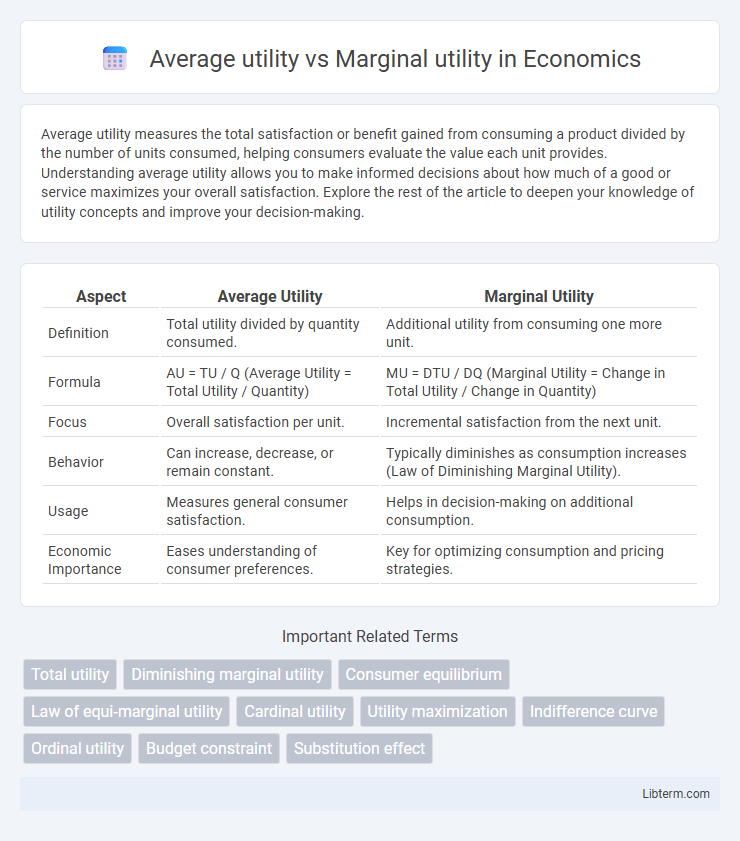Average utility measures the total satisfaction or benefit gained from consuming a product divided by the number of units consumed, helping consumers evaluate the value each unit provides. Understanding average utility allows you to make informed decisions about how much of a good or service maximizes your overall satisfaction. Explore the rest of the article to deepen your knowledge of utility concepts and improve your decision-making.
Table of Comparison
| Aspect | Average Utility | Marginal Utility |
|---|---|---|
| Definition | Total utility divided by quantity consumed. | Additional utility from consuming one more unit. |
| Formula | AU = TU / Q (Average Utility = Total Utility / Quantity) | MU = DTU / DQ (Marginal Utility = Change in Total Utility / Change in Quantity) |
| Focus | Overall satisfaction per unit. | Incremental satisfaction from the next unit. |
| Behavior | Can increase, decrease, or remain constant. | Typically diminishes as consumption increases (Law of Diminishing Marginal Utility). |
| Usage | Measures general consumer satisfaction. | Helps in decision-making on additional consumption. |
| Economic Importance | Eases understanding of consumer preferences. | Key for optimizing consumption and pricing strategies. |
Introduction to Utility in Economics
Utility in economics measures the satisfaction or benefit consumers derive from goods and services. Average utility calculates the total utility gained per unit consumed, while marginal utility assesses the additional satisfaction from consuming one more unit. Understanding these concepts helps explain consumer choice behavior and demand patterns within markets.
Defining Average Utility
Average utility measures the total utility gained from consuming a certain quantity of goods divided by that quantity, representing the satisfaction per unit. It provides a broad view of consumer satisfaction across all units consumed rather than the incremental satisfaction from an additional unit. Understanding average utility helps in analyzing overall consumer preference and decision-making in economic theory.
Understanding Marginal Utility
Marginal utility measures the additional satisfaction gained from consuming one more unit of a good, reflecting changes in overall utility, while average utility calculates the total utility divided by the number of units consumed. Understanding marginal utility is crucial for decision-making, as it helps determine the optimal quantity of a good by comparing the extra benefit received to its cost. This concept explains consumer behavior and the law of diminishing marginal utility, where each additional unit provides less utility than the previous one.
Key Differences between Average and Marginal Utility
Average utility measures the total satisfaction gained from consuming a good divided by the quantity consumed, reflecting overall consumer satisfaction per unit. Marginal utility represents the additional satisfaction obtained from consuming one more unit of a good, highlighting the incremental change in utility. Key differences include that average utility shows overall consumption efficiency, while marginal utility provides insight into consumer decision-making at the margin and diminishes as more units are consumed.
Mathematical Representation of Utilities
Average utility is calculated by dividing total utility by the quantity of goods consumed, represented as AU = TU/Q, where AU is average utility, TU is total utility, and Q is quantity. Marginal utility is the change in total utility resulting from consuming an additional unit of a good, expressed as MU = DTU/DQ, where MU denotes marginal utility, DTU is the change in total utility, and DQ is the change in quantity. These mathematical representations help quantify consumer satisfaction and guide optimal consumption decisions.
Importance of Marginal Utility in Decision Making
Marginal utility measures the additional satisfaction gained from consuming one more unit of a good, playing a critical role in economic decision-making by helping consumers optimize resource allocation. Unlike average utility, which calculates the total utility per unit consumed, marginal utility guides choices at the margin, enabling consumers and firms to determine the optimal quantity of goods to maximize overall benefit. Understanding diminishing marginal utility allows decision-makers to predict changes in demand and efficiently balance costs and benefits in consumption and production.
Average Utility in Consumer Behavior
Average utility represents the total satisfaction a consumer derives from consuming a good divided by the quantity consumed, reflecting overall well-being per unit. It helps in understanding consumer behavior by indicating how much utility each unit provides on average, guiding consumption choices and demand patterns. As consumption increases, Average utility typically changes, influencing how consumers allocate their resources across different goods.
Diminishing Marginal Utility Explained
Average utility reflects the total satisfaction per unit consumed, while marginal utility measures the additional satisfaction from consuming one more unit. Diminishing marginal utility occurs when each extra unit consumed provides less added satisfaction than the previous one, a fundamental principle in consumer behavior economics. This concept explains why demand curves slope downward and why consumers diversify their purchases.
Practical Examples: Average vs. Marginal Utility
Average utility measures the total satisfaction gained per unit consumed, while marginal utility evaluates the additional satisfaction from consuming one more unit. For example, eating three slices of pizza may yield an average utility of 8 satisfaction points per slice, but the marginal utility of the third slice might drop to 4 points as hunger decreases. Understanding these concepts helps consumers make choices that maximize overall happiness by comparing the incremental benefit of each additional unit to the average benefit obtained from all units consumed.
Implications for Economic Policy and Analysis
Understanding the distinction between average utility and marginal utility is crucial for effective economic policy formulation, as marginal utility guides decisions on resource allocation to maximize social welfare. Policies targeting areas where marginal utility diminishes rapidly can improve efficiency by redirecting resources to sectors with higher marginal returns. Analyzing both concepts helps economists predict consumer behavior and optimize taxation, subsidies, and public goods provisioning to enhance overall economic welfare.
Average utility Infographic

 libterm.com
libterm.com